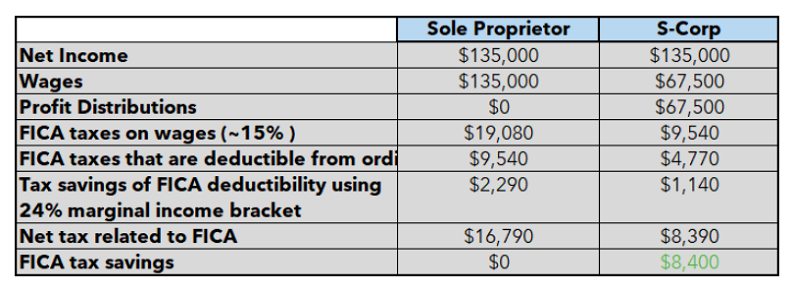
S-Corporations are unique business entities with a distinctive tax structure that allows them to pass income, deductions, and credits through to their shareholders for federal tax purposes. One standout feature of S-Corporations is their ability to make distributions to shareholders, an area often fraught with complexity, but also filled with opportunities for savvy tax planning. Here we unpack the concept of S-Corporation distributions, explore their taxation implications, and demonstrate how they can be strategically used in tax planning.
Contents
Introduction to S-Corporations
Navigating the complex landscape of corporate structures can be challenging. Among the myriad of business entity types, S-Corporations stand out due to their unique characteristics and taxation rules.
Brief Overview of S-Corporations
S-Corporations, also known as Subchapter S Corporations, are a specific type of corporation created through an IRS tax election. An eligible domestic corporation can avoid double taxation – once to the corporation and again to the shareholders – by electing to be treated as an S-Corporation. S-Corporations combine the legal protections of a corporation with the tax benefits of a partnership or sole proprietorship.
This type of entity is especially popular among small and family businesses due to its ability to provide owners with limited liability protection, while typically avoiding the double taxation that conventional corporations (C-Corporations) are subject to.
The Unique Tax Structure of S-Corporations
What sets S-Corporations apart is their unique tax structure. Unlike traditional C-Corporations, which pay corporate income taxes, S-Corporations are considered “pass-through” entities. This means that rather than paying income taxes at the corporate level, the company’s profits or losses are passed directly to the shareholders’ individual tax returns.
The benefit of this arrangement is that business profits are only taxed once – at the individual shareholder level – thereby avoiding the double taxation scenario that C-Corporations face [1].
Understanding the Concept of Distributions in S-Corporations
Distributions refer to the earnings that an S-Corporation passes on to its shareholders. These distributions, often in the form of dividends, are one of the ways that shareholders receive a return on their investment in the company.
One noteworthy aspect of S-Corporations is that these distributions are typically tax-free, as the corporation’s income is already taxed at the shareholder level. However, it’s not as simple as it might seem. The tax implications of these distributions can vary based on several factors, including whether the distribution exceeds the shareholder’s stock basis or if the corporation has accumulated earnings and profits from when it was a C-Corporation.

The Basics of S-Corporation Taxation
Now that we have a fundamental understanding of S-Corporations, let’s get into the finer details of how they are taxed. It’s critical to grasp these basics to appreciate the unique role distributions can play in tax planning for S-Corporations.
Taxation at the Corporate Level
Unlike traditional C-Corporations, S-Corporations don’t pay federal income taxes at the corporate level. Instead, they file an informational tax return (Form 1120S) reporting their income, deductions, and credits. This return provides the IRS with a snapshot of the corporation’s financial status but doesn’t lead to a tax bill for the corporation itself.
However, it’s important to note that S-Corporations may still be liable for certain state-level taxes, and in some cases, may be subject to a federal tax known as the “Built-In Gains Tax,” particularly if they were formerly C-Corporations.
Pass-Through Taxation: A Key Advantage of S-Corporations
One of the biggest advantages of an S-Corporation is its pass-through tax status. The profits (or losses) of an S-Corporation pass directly through to the shareholders and are reported on their individual tax returns.
Shareholders then pay tax on this income at their personal income tax rates. This can be a significant benefit, as it avoids the double taxation encountered by C-Corporations – first on corporate profit and again on dividends distributed to shareholders [2].
As we’ve learned, S-Corporation shareholders are taxed on their share of the company’s profits. This occurs whether or not these profits are actually distributed to the shareholders.
For example, if an S-Corporation earns $100,000 in a year and has two equal shareholders, each shareholder will report $50,000 of income from the S-Corporation on their personal tax return, irrespective of whether any money was actually distributed to them. This concept, called “phantom income,” is an essential feature of pass-through taxation that shareholders must be aware of.
On the positive side, losses of an S-Corporation can also pass through to shareholders. These losses can be used to offset other income on the shareholders’ tax returns, subject to certain restrictions related to the shareholder’s basis in the S-Corporation and their participation in the business.

The Role of Distributions in S-Corporations
Understanding the role of distributions in S-Corporations is key to unraveling their potential for tax planning.
Definition and Types of S-Corporation Distributions
In an S-Corporation, distributions are typically the profits that the corporation distributes to its shareholders. These profits are usually dispensed as dividends, which are proportionate to each shareholder’s interest in the corporation. However, distributions can also take the form of property or a reduction in the S-Corporation’s loans to shareholders.
While distributions often come from the corporation’s profits, S-Corporations may also distribute their accumulated adjustments account (AAA), previously taxed income that has not yet been distributed, and loans to shareholders.
The Tax Implications of S-Corporation Distributions
At first glance, one might think that S-Corporation distributions are tax-free since the income of an S-Corporation is taxed at the shareholder level. However, the reality is more nuanced.
S-Corporation distributions are indeed tax-free to the extent of a shareholder’s basis in the corporation. The basis initially equals the amount the shareholder invested in the company, but it fluctuates over time, increasing with income and additional investments, and decreasing with losses and distributions [3].
If distributions exceed a shareholder’s basis, they are generally treated as capital gains and are subject to tax. Moreover, if the S-Corporation was previously a C-Corporation and has accumulated earnings and profits, distributions could be classified as dividends and may be taxable.
Difference Between Salary and Distribution in S-Corporation Taxation
Understanding the difference between salary and distributions in an S-Corporation is crucial for effective tax planning. While both represent ways for shareholders to extract money from the corporation, they are taxed differently.
Salaries are subject to employment taxes (Social Security and Medicare), whereas distributions are not. However, the IRS requires that any shareholder who provides services to the S-Corporation receive “reasonable compensation” in the form of a salary before any distributions are made.
While it might be tempting to take all money out of the S-Corporation as distributions to avoid employment taxes, the IRS watches for this and can reclassify distributions as wages if they conclude that a shareholder hasn’t been paid a reasonable salary.

How to Utilize S-Corporation Distributions in Tax Planning
Now that we have a solid grasp on the role of S-Corporation distributions and their taxation, we can dig into the strategic use of distributions for tax planning. The goal here is to leverage the tax rules of S-Corporations to your benefit, optimizing your tax burden while staying within the confines of the law.
Balancing Salary and Distributions: A Key to Minimize Taxes
The most common tax planning strategy for S-Corporations involves balancing salaries and distributions. By minimizing salaries (and thus employment taxes) and maximizing distributions, you can potentially achieve significant tax savings.
However, the IRS requires that shareholders-employees receive “reasonable compensation” for their services before receiving any distributions. What constitutes “reasonable” is somewhat subjective and can depend on factors like the individual’s role, responsibilities, experience, and the pay rates for similar roles in your industry and location.
While there is no definitive method to determine reasonable compensation, it’s crucial to have a logical and well-documented process for setting salaries. Doing so will provide a solid defense should the IRS ever question your salary-distribution balance [4].
The Role of Reasonable Compensation in S-Corporation Tax Planning
As mentioned earlier, the IRS insists on reasonable compensation for shareholder-employees before any distributions are made. This can seem like a hindrance to tax planning, but it can also offer opportunities.
Reasonable compensation affects both your income tax and your employment tax. While increasing salary may raise employment taxes, it can also provide more room for retirement contributions (which are typically tied to salary), potentially leading to greater tax-deferred growth.
The key is to take a holistic view of your taxes and financial goals when determining reasonable compensation. It isn’t just about minimizing taxes today; it’s also about setting the stage for long-term financial health.
Risks and Rewards of Choosing Distributions Over Salary
Choosing distributions over salary can offer substantial tax savings, but it’s not without risks. If the IRS determines that an S-Corporation’s shareholder-employee’s salary is unreasonably low, it can reclassify distributions as wages, resulting in additional tax, penalties, and interest.
To mitigate this risk, S-Corporations should document how they determine reasonable compensation and compare it to industry standards. They should also ensure that they are making distributions proportionally based on ownership interests.
Advanced Tax Planning Strategies for S-Corporations
Now that we have explored the fundamentals of S-Corporation distributions and their tax implications, let’s examine more advanced tax planning strategies. These methods, though complex, can provide significant tax benefits when applied correctly. It’s important to remember that each S-Corporation’s situation is unique, and what works for one may not work for another.
Making the Most of S-Corporation Losses
One advantage of the S-Corporation structure is the ability to pass losses through to shareholders. These losses can be used to offset other income, thereby reducing the shareholder’s overall tax liability.
However, to claim these losses, a shareholder must have sufficient “basis” in their S-Corporation stock. Basis is a tax concept that measures a shareholder’s investment in the company. It is increased by capital contributions and income and reduced by losses and distributions [5].
If a shareholder does not have sufficient basis to deduct losses, they are not lost forever. Instead, they are “suspended” and can be deducted in future years when the shareholder has adequate basis.
Planning around basis limitations can be complex but can lead to significant tax savings. It may involve timing of distributions and contributions or loans to the S-Corporation, and it must also consider the at-risk and passive activity loss rules.
The Importance of Accurate Record-Keeping and Basis Tracking
Accurate record-keeping is essential for S-Corporations. It’s crucial to keep track of all income, deductions, and credits, as well as distributions and any changes to shareholders’ stock and debt basis.
Having a system in place to track each shareholder’s basis in their S-Corporation stock and debt can help ensure that income and losses are reported correctly, and that distributions are made in the most tax-efficient manner. Accurate records can also provide valuable support in the event of an IRS audit.
Planning for the Built-In Gains Tax
If an S-Corporation was formerly a C-Corporation or acquired assets from a C-Corporation in a tax-free transaction, it may be subject to a built-in gains tax. This tax applies to the “built-in gain” on assets that the corporation held at the time of the S-election or acquisition, if those assets are sold within five years.
Planning around the built-in gains tax can involve timing of asset sales, valuation of assets, and monitoring of the corporation’s accumulated earnings and profits.
Remember, these advanced tax planning strategies often require the help of a tax professional. It’s always wise to seek expert advice when dealing with the intricate world of S-Corporation taxation.
References
[1] Determining the Taxability of S Corporation Distributions
[2] Taxation of S Corporation Shareholders
[3] Income and Estate Tax Planning with Subchapter S-Corporations
[4] S Corp Tax Strategies, Deductions and Loopholes
[5] Should you incorporate your firm as an S corporation?
